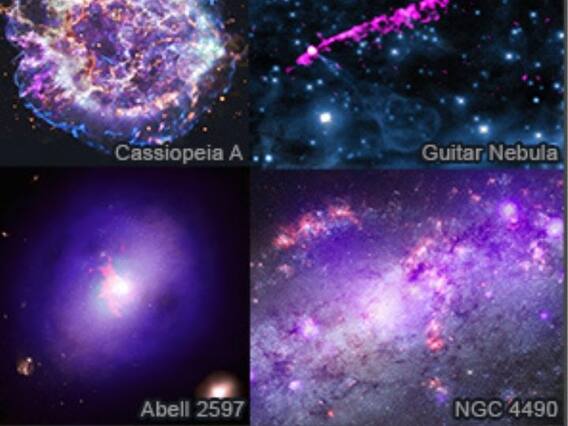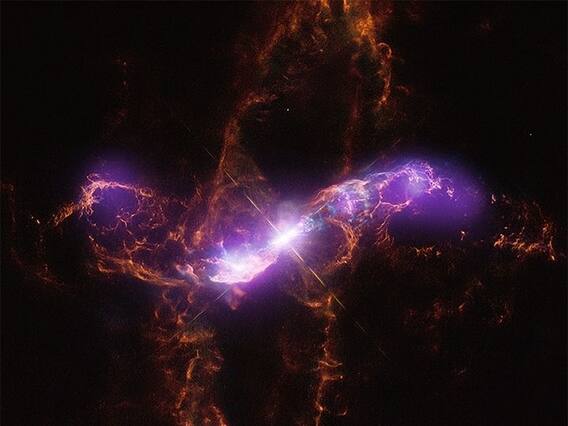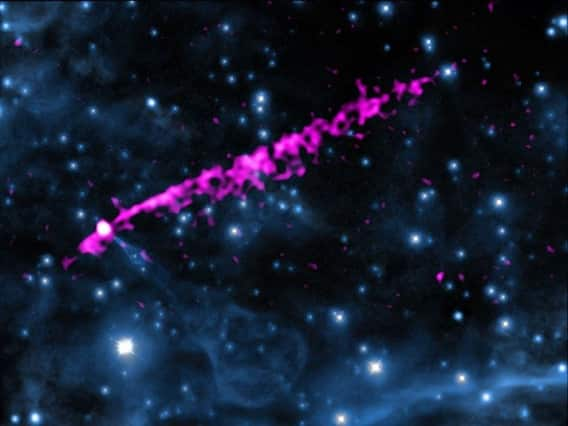Science
IN PICS | Supernova Remnant To Galaxy Cluster — Images Combining Data From NASA’s Chandra & Other Telescopes




 Composite image of Guitar Nebula: Astronomers have been puzzled by the alignment of some jets of X-rays coming from very fast-moving pulsars or spinning neutron stars that shoot out into interstellar space at odd, unexpected angles. PSR B2224+65 is a pulsar found near the structure nicknamed the “Guitar Nebula” due to its shape in optical light (blue), and astronomers see jets of X-rays coming from it. | Photo: NASA Chandra X-ray Observatory
Composite image of Guitar Nebula: Astronomers have been puzzled by the alignment of some jets of X-rays coming from very fast-moving pulsars or spinning neutron stars that shoot out into interstellar space at odd, unexpected angles. PSR B2224+65 is a pulsar found near the structure nicknamed the “Guitar Nebula” due to its shape in optical light (blue), and astronomers see jets of X-rays coming from it. | Photo: NASA Chandra X-ray Observatory X-ray image of Guitar Nebula: Chandra captured an X-ray stream (pink) which is pointed nearly perpendicular to the guitar-shaped structure. | Photo: NASA Chandra X-ray Observatory
X-ray image of Guitar Nebula: Chandra captured an X-ray stream (pink) which is pointed nearly perpendicular to the guitar-shaped structure. | Photo: NASA Chandra X-ray Observatory Galaxy Cluster Abell 2597 has a giant central supermassive black hole which is driving the gas outward and creating bubbles, or voids, within it. The composite image of Abell 2597 includes X-rays from Chandra (blue), optical data from the Digitized Sky Survey (orange), and emission from hydrogen atoms in optical light from the Las Campanas Observatory in Chile (red). | Photo: NASA Chandra X-ray Observatory
Galaxy Cluster Abell 2597 has a giant central supermassive black hole which is driving the gas outward and creating bubbles, or voids, within it. The composite image of Abell 2597 includes X-rays from Chandra (blue), optical data from the Digitized Sky Survey (orange), and emission from hydrogen atoms in optical light from the Las Campanas Observatory in Chile (red). | Photo: NASA Chandra X-ray Observatory The gravitational interaction between two merging galaxies can trigger waves of star formation. This happens in NGC 4490, a spiral galaxy which has collided with a smaller galaxy to the upper right but not seen in the image | Photo: NASA Chandra X-ray Observatory
The gravitational interaction between two merging galaxies can trigger waves of star formation. This happens in NGC 4490, a spiral galaxy which has collided with a smaller galaxy to the upper right but not seen in the image | Photo: NASA Chandra X-ray ObservatoryComplete News Source : abplive
health and remedies
Patterns of behaviour that emerge after trauma
Trauma is a deeply distressing or disturbing experience that can leave a lasting impact on a person’s mental and emotional health. It can result from a range of events, such as natural disasters, accidents, physical or emotional abuse, or military combat. Trauma can have a significant effect on a person’s behavior and can manifest in various ways. Here are some patterns of behavior that often emerge after trauma:
- Hyperarousal: After experiencing trauma, a person may feel constantly on edge, with heightened levels of anxiety and tension. This can manifest as irritability, restlessness, and difficulty sleeping.
- Avoidance: Trauma can also cause a person to avoid situations, people, or places that remind them of the traumatic experience. This can lead to social withdrawal, isolation, and a loss of interest in previously enjoyable activities.
- Emotional numbness: Trauma can cause a person to feel emotionally disconnected or numb, making it difficult for them to experience positive emotions such as joy or love.
- Hypervigilance: A person who has experienced trauma may be hyper-aware of their surroundings and perceive threats where none exist. This can lead to an increased sense of danger, which can trigger anxiety or panic attacks.
- Flashbacks: Trauma can cause a person to experience vivid and intrusive memories of the traumatic event. These flashbacks can be triggered by a range of stimuli, such as sights, sounds, or smells.
- Guilt and shame: Trauma can cause a person to experience feelings of guilt, shame, and self-blame. They may feel responsible for what happened to them, even when it was beyond their control.
- Substance abuse: Trauma can lead to the use of drugs or alcohol as a way of coping with difficult emotions. This can quickly become a self-destructive pattern of behavior that exacerbates the trauma.
It’s important to note that not everyone who experiences trauma will display all of these behaviors, and that each person’s response to trauma is unique. However, recognizing these patterns of behavior can help individuals and their loved ones identify when trauma may be a contributing factor to mental and emotional health challenges. Seeking professional support, such as therapy or counseling, can help individuals process their trauma and learn healthy coping mechanisms to manage their behavior.
Was this response better or worse?BetterWorseSame
Group Media Publications
Entertainment News Platforms – anyflix.in
Construction Infrastructure and Mining News Platform – https://cimreviews.com/
General News Platform – https://ihtlive.com/
Podcast Platforms – https://anyfm.in
-

 Bollywood2 months ago
Bollywood2 months agoAishwarya Rai maintains her stunning appearance in a new L’Oreal ad.
-

 health and remedies2 months ago
health and remedies2 months agoThe article discusses the potential health risks associated with swallowing dry ice
-
.jpg)
.jpg) Music1 month ago
Music1 month agoSidhu Moosewala’s father and baby brother feature on Times Square billboard; fans react. Watch
-
Bollywood4 weeks ago
Rasha, the daughter of Raveena Tandon, discusses how trolling affects her: “I think in processing it, feeling bad for a bit.”
-

 Bollywood1 month ago
Bollywood1 month agoThe phrase “female-led projects” annoys Bhumi Pednekar. “It disgusts me deeply.”
-

 Bollywood2 months ago
Bollywood2 months agoFor this explosive advertisement, Aamir Khan and Darsheel Safary reconnect 16 years after Taare Zameen Par
-
.jpg)
.jpg) Hollywood2 months ago
Hollywood2 months agoOri, Gal Gadot’s fourth daughter, is welcomed into the world. “Being pregnant wasn’t easy,”
-

 Entertainment2 months ago
Entertainment2 months agoEach of Vijay and Kamal Haasan donates ₹1 crore to the construction of Nadigar Sangam













